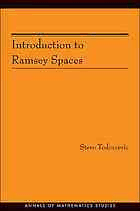
Introduction to Ramsey spaces PDF
Preview Introduction to Ramsey spaces
Annals of Mathematics Studies Number 174 This page intentionally left blank Introduction to Ramsey Spaces Stevo Todorcevic PRINCETON UNIVERSITY PRESS PRINCETON AND OXFORD 2010 Copyright(cid:13)c 2010byPrincetonUniversityPress PublishedbyPrincetonUniversityPress 41WilliamStreet,Princeton,NewJersey08540 IntheUnitedKingdom:PrincetonUniversityPress 6OxfordStreet, Woodstock, OxfordshireOX201TW AllRightsReserved LibraryofCongressCataloging-in-PublicationData Todorcevic, Stevo IntroductiontoRamseySpaces/StevoTodorcevic. p.cm.(Annalsofmathematics studies;no.174) Includesbibliographicalreferencesandindex. ISBN978-0-691-14541-9(hardcover :alk.paper) ISBN978-0-691-14542-6(pbk.:alk.paper) 1.Ramseytheory.2.Algebraicspaces.I.Title. QA166.T6352010 511’.5–dc22 2009036738 BritishLibraryCataloging-in-PublicationDataisavailable ThisbookhasbeencomposedinLATEX The publisher would like to acknowledge the author of this volume for providingthecamera-readycopyfromwhichthisbookwasprinted. Printedonacid-freepaper.∞ press.princeton.edu PrintedintheUnitedStates ofAmerica 10987654321 Contents Introduction 1 Chapter1. Ramsey Theory: Preliminaries 3 1.1 Coideals 3 1.2 Dimensions in Ramsey Theory 5 1.3 Higher Dimensions in Ramsey Theory 10 1.4 Ramsey Property and Baire Property 20 Chapter2. Semigroup Colorings 27 2.1 Idempotentsin Compact semigroups 27 2.2 The Galvin-Glazer Theorem 30 2.3 Gowers’s Theorem 34 2.4 A Semigroup of SubsymmetricUltrafilters 38 2.5 The Hales-Jewett Theorem 41 2.6 Partial Semigroup of Located Words 46 Chapter3. Trees and Products 49 3.1 Versions of the Halpern-L¨auchliTheorem 49 3.2 A Proof of theHalpern-L¨auchli Theorem 55 3.3 Products of Finite Sets 57 Chapter4. Abstract Ramsey Theory 63 4.1 Abstract Baire Property 63 4.2 The Abstract Ramsey Theorem 68 4.3 Combinatorial Forcing 76 4.4 The Hales-Jewett Space 83 4.5 Ramsey Spaces of InfiniteBlock Sequencesof Located Words 89 Chapter5. Topological Ramsey Theory 93 5.1 Topological Ramsey Spaces 93 5.2 Topological Ramsey Spaces of InfiniteBlock Sequencesof Vectors 99 5.3 Topological Ramsey Spaces of Infinite Sequencesof Variable Words 105 5.4 Parametrized Versions of RosenthalDichotomies 111 5.5 Ramsey Theory of Superperfect Subsetsof Polish Spaces 117 5.6 DualRamsey Theory 121 vi CONTENTS 5.7 A Ramsey Space of Infinite-Dimensional Vector Subspacesof FN 127 Chapter6. Spaces of Trees 135 6.1 A Ramsey Space of Strong Subtrees 135 6.2 Applications of the Ramsey Space of Strong Subtrees 138 6.3 Partition Calculus on Finite Powers of theCountable DenseLin- ear Ordering 143 6.4 A Ramsey Space of Increasing Sequencesof Rationals 149 6.5 ContinuousColorings on Q[k] 152 6.6 SomePerfect Set Theorems 158 6.7 AnalyticIdealsandPointsinCompactSetsoftheFirstBaireClass 165 Chapter7. Local Ramsey Theory 179 7.1 Local Ellentuck Theory 179 7.2 Topological Ultra-Ramsey Spaces 190 7.3 SomeExamples of Selective Coideals on N 194 7.4 SomeApplications of Ultra-Ramsey Theory 198 7.5 Local Ramsey Theory and Analytic Topologies on N 202 7.6 Ultra-Hales-Jewett Spaces 207 7.7 Ultra-Ramsey Spaces of Block Sequencesof Located Words 212 7.8 Ultra-Ramsey Space of Infinite Block Sequencesof Vectors 215 Chapter8. Infinite Products of FiniteSets 219 8.1 SemicontinuousColorings of Infinite Products of Finite Sets 219 8.2 Polarized Ramsey Property 224 8.3 Polarized Partition Calculus 231 Chapter9. Parametrized Ramsey Theory 237 9.1 HigherDimensional Ramsey Theorems Parametrized by InfiniteProducts of Finite Sets 237 9.2 Combinatorial Forcing Parametrized by InfiniteProducts of Finite Sets 243 9.3 Parametrized Ramsey Property 248 9.4 Infinite-DimensionalRamsey Theorem Parametrized by InfiniteProducts of Finite Sets 254 Appendix 259 Bibliography 271 Subject Index 279 Index of Notation 285 Introduction to Ramsey Spaces This page intentionally left blank 1 Introduction This book is intended to be an introduction to a rich and elegant area of Ramseytheorythatconcernsitselfwithcoloringinfinitesequencesofobjects and which is for this reason sometimes called infinite-dimensional Ramsey theory. Transferringbasic pigeonhole principles to their higher dimensional versionsto increasetheir applicabilityis thus the subjectmatterofthis the- ory. In fact, this tendency in Ramsey theory could be traced back to the invention of the original Ramsey theorem, which is nothing other than a higher dimensionalversionofthe principle that saysthat afinite coloringof aninfinitesetmustinvolveatleastoneinfinitemonochromaticsubset.Ram- sey’s original application of the finite-dimensional Ramsey theorem was to obtain a rough classification of relational structures on the set N of natural numbersthatheneededforadecisionprocedurethatwouldtestthevalidity of a certain kind of logical sentence. This original application of the finite- dimensionalRamseytheoremwasmatchedindepthonlyfortyyearslaterby the Brunel-Suchestonuseofthistheoreminshowingthe existenceofthe so- calledspreadingmodelofagivenBanachspace,anotionthathaseventually triggeredimportantdevelopmentsinthatareaofmathematics.Theinfinite- dimensional extension was also done for utilitarian reasons. It was initiated forty years ago by Nash-Williams in the course of developing his theory of better-quasi-ordered sets that eventually led him to the proof of that trees arewell-quasi-orderedundertheembedabilityrelation.Thefullstatementof the infinite-dimensional Ramsey theorem came, however, only through the workofGalvin-Prikry,Silver,Mathias,andespeciallyEllentuck,whowasthe firsttousetopologicalnotionstodescribewhatistodaygenerallyconsidered the optimal form of this result. In this book we present a generalprocedure to transfer any other Ramsey theoretic principles to higher and especially infinite dimensions trying to match the clarity of the Ellentuck result, but going beyond his topological Ramsey theory. As seen in the prototype ex- ampleoftheRamseyspaceofinfinitesequencesofwordsandvariablewords over a fixed finite alphabet, topological Ramsey theory fails to capture the situationinwhichtheobjectsthatgeneratecombinatorialsubspacesarenot the objects that one colors. For this, one needs the new theory of Ramsey spacesinwhichtherearenonaturaltopologiestodescribethecomplexityof the allowedcolorings.Inotherwords,the new theoryaddressesnotonlythe challengingproblemoffindingtherighthypothesisforthecoloringsbutalso the problem of whether such a hypothesis can be preserved under classical operations such as the Souslin operation. The topological Ramsey theory
